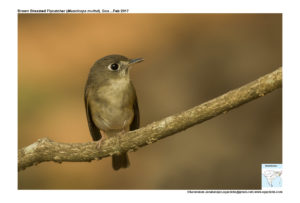Brown-breasted Flycatcher

Brown-breasted Flycatcher Muscicapa muttui
Etymology:
- Muscicapa : Latin Word musca – fly; capere – to catch
- Muttui : Muttui (fl. 1850), Sinhalese servant, hunter and collector for Edgar Layard
Vernacular Names: Mal: Muttupilla, Mar: Tapkiri chatichi Mashimar
Distribution in India: Breeds in North East India and winters in South West India.
Description:Size of 13-14 cm. It is a medium-sized, large-headed, olive-brown forest flycatcher with large eye and broad eyering, long and thin bill. Head and upperparts are olive-brown, slightly darker on forehead and crown, warmer or rufous on rump and tail; pale buff to whitish lores, broad buffish to whitish eyering; cheek greyish, distinct whitish submoustachial stripe and narrow dark malar stripe; tips of greater upperwing-coverts and edges of tertials and inner secondaries light rufous-buff, flight-feathers dark brown; chin and throat whitish, breast and flanks buffish-brown (slightly warmer on flanks), rest of underparts whitish; iris dark brown; upper mandible dark brown with pale horn tip, culmen characteristically curved, lower mandible pale yellow, often darkening towards tip; legs pale yellowish-pink. Both sexes are alike.
Habitat: It is found along banks of rivers in lowland forest and broadleaf evergreen forest, between 1200 m and 1645 m.
Food Habits: It eats small invertebrates, like flies and beetles. Usually solitary or in pairs in breeding season. Forages in dense vegetation, including bamboo, and lower levels of forest trees. It is quiet, retiring and partly crepuscular; spends long periods almost motionless on low perch before dashing after passing insect. It holds feeding territories in non-breeding season; often in same locality for long periods.
Breeding Habits: They breed in Apr-June in India. The nest is a neat cup-shaped structure made entirely of moss, placed in dense bush, creepers or low tangled vegetation or on bank in thick cover. It lays a clutch 4–5 eggs. The incubation is done by both sexes.